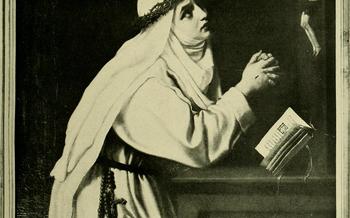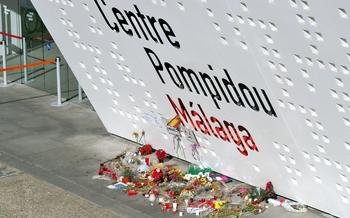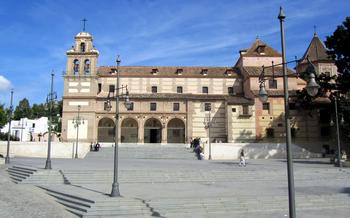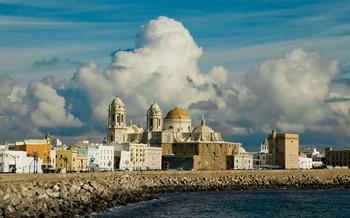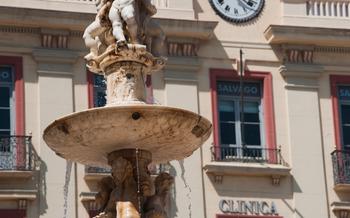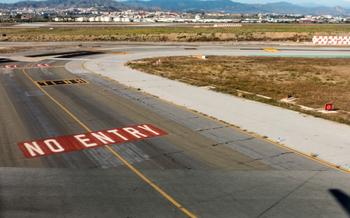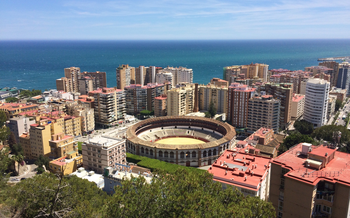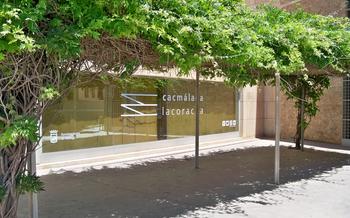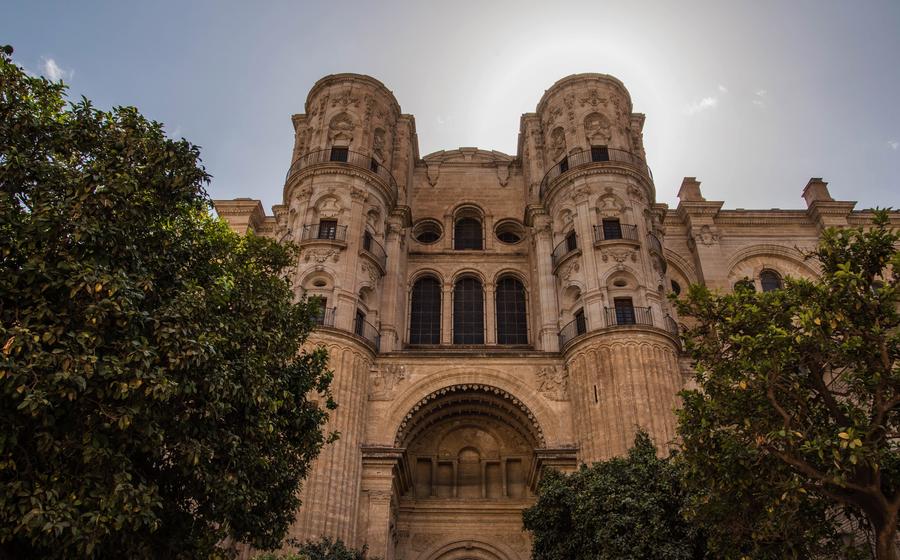
Málaga Cathedral
- Architectural Beauty
- Religious Importance
- UNESCO Recognition
- Rooftop Views
- Interior Chapels
- Museum and Archives
- Music and Worship
- A Walk Through History
- Local Traditions
- Practical Information
- Accessibility
- Photography Guidelines
- Respectful Photography:
- Usage Restrictions:
- Capture the Essence:
- Nearby Attractions
- Insider Tip
Architectural Beauty
Gothic Masterpiece: Málaga Cathedral's architectural style is a prime example of Gothic architecture, predominantly from the 16th century. Its graceful silhouette and intricate details are a testament to the skill and artistry of the master builders. The ribbed vaults, pointed arches, and flying buttresses create a sense of height and grandeur that is both awe-inspiring and serene.
Exterior Design: The cathedral's façade is a masterpiece of Gothic ornamentation, featuring a profusion of sculptures, carvings, and intricate tracery. The main portal, known as the Puerta del Sagrario, is particularly impressive with its delicate carvings and statues of saints and biblical figures. The soaring tower, known as the Torre de la Catedral, is a landmark in its own right, offering panoramic views of the city and the surrounding countryside.
Interior Grandeur: The cathedral's interior is equally impressive, with its soaring nave, elegant chapels, and stunning altarpiece. The nave is lined with massive pillars that support the vaulted ceiling, creating a sense of space and majesty. The chapels, dedicated to various saints, are adorned with intricate carvings, paintings, and stained-glass windows, each telling a unique story from the Bible or the lives of the saints. The highlight of the interior is the magnificent altarpiece, which is considered one of the finest examples of Spanish Renaissance art.
Religious Importance
The Málaga Cathedral holds immense religious significance as a prominent Catholic center in the city. Constructed on the site of a former mosque, the cathedral embodies the triumph of Christianity over Islamic rule during the Reconquista. It is dedicated to the Virgin Mary, known locally as La Virgen de la Victoria, who is revered as the patron saint of Málaga. The cathedral serves as a place of worship, pilgrimage, and spiritual reflection for the local Catholic community.
Pilgrims from across the region and beyond flock to the cathedral to pay homage to La Virgen de la Victoria. Her image, beautifully adorned in intricate robes, is displayed prominently within the cathedral, attracting devotees who seek her blessings and intercession. The cathedral also plays a vital role in the city's religious festivals and processions, particularly during Holy Week, when elaborate ceremonies and processions fill the streets of Málaga.
The cathedral's religious importance is further underscored by its status as a pilgrimage site. Each year, thousands of pilgrims embark on the "Camino de la Virgen," a pilgrimage route that leads to the cathedral. This pilgrimage is a testament to the deep devotion and spiritual connection that many people feel towards the cathedral and its patron saint.
UNESCO Recognition
Cultural Heritage: The Málaga Cathedral stands as a testament to the city's rich cultural heritage. Its architectural magnificence has earned it a coveted spot on the UNESCO World Heritage List, a testament to its exceptional cultural significance. The cathedral's inclusion on this prestigious list recognizes its outstanding universal value and its contribution to the world's cultural tapestry.
Architectural Value: The cathedral's architectural prowess has garnered widespread recognition. Its Gothic design, intricate carvings, and soaring spires have been lauded by experts and enthusiasts alike. The UNESCO designation acknowledges the cathedral's exceptional architectural value, highlighting its unique blend of styles and its contribution to the development of Gothic architecture in the region.
Historical Importance: The cathedral's historical significance has been duly recognized by UNESCO. Its listing as a World Heritage Site acknowledges its role as a witness to Málaga's tumultuous past. From its humble origins as a mosque during the Moorish period to its transformation into a Christian cathedral following the Reconquista, the cathedral has stood at the heart of the city's evolution. Its UNESCO status underscores its enduring historical value and its role in shaping the identity of Málaga.
Rooftop Views
Ascend to the rooftop of the Málaga Cathedral for an unparalleled panoramic perspective of the city and its surroundings. Open to visitors, the accessible terraces offer a breathtaking vista that encompasses the historic cityscape, the sparkling Mediterranean Sea, and the verdant mountains. Capture the essence of Málaga's beauty in photographs, immortalizing the moment from this unique vantage point. The panoramic views from the cathedral's rooftop are not to be missed, providing a bird's-eye perspective of the city's architectural wonders, vibrant neighborhoods, and the vast expanse of the Mediterranean Sea.
Interior Chapels
Enrich your visit to the Málaga Cathedral by exploring its captivating interior chapels. Each chapel holds artistic treasures, intricate altars, and historical significance that will leave you in awe.
Discover the Capilla Mayor, the main chapel, showcasing an awe-inspiring altarpiece adorned with intricate carvings and vibrant colors. Admire the Capilla del Sagrario, featuring a beautiful tabernacle and a stunning fresco ceiling.
Seek out the Capilla de Nuestra Señora de la Victoria, dedicated to the patron saint of Málaga. Marvel at the exquisite altarpiece depicting scenes from her life and the intricate silverwork that adorns the chapel.
Don't miss the Capilla de San Francisco, housing the tomb of the Catholic Monarchs, Ferdinand and Isabella, who played a pivotal role in the history of Spain.
Take your time to explore each chapel, uncovering the stories behind the artwork, the saints they represent, and the historical events that have shaped this sacred space.
Museum and Archives
Housed within the cathedral complex, the Cathedral Museum and Diocesan Archives are treasure troves of history and religious art. The museum showcases a fascinating collection of artifacts, religious relics, and liturgical objects that narrate the rich history of the cathedral and the diocese. Visitors can marvel at intricately crafted gold and silverwork, ancient manuscripts, and paintings that depict scenes from the Bible and the lives of saints.
The Diocesan Archives, on the other hand, offer a glimpse into the written history of the cathedral and the diocese. Here, researchers and history enthusiasts can delve into a vast collection of documents, including papal bulls, royal decrees, and personal letters that shed light on the religious, social, and political climate of Malaga throughout the centuries. Guided tours are available for both the museum and the archives, providing visitors with an in-depth understanding of the cathedral's heritage and the significance of its preserved artifacts.
Music and Worship
The Málaga Cathedral is not just a historical and architectural marvel; it is also a vibrant center of religious devotion and musical expression. The cathedral's acoustics are renowned for their clarity and resonance, making it an ideal venue for concerts and choral performances.
Throughout the year, the cathedral hosts a variety of musical events, including organ concerts, choral performances, and religious ceremonies. These events showcase the talents of local and international musicians and provide visitors with a unique opportunity to experience the cathedral's spiritual and cultural heritage.
During organ concerts, the majestic tones of the cathedral's pipe organ fill the air, creating an awe-inspiring atmosphere. The organ, built in the 18th century, is a masterpiece of craftsmanship and is considered one of the finest instruments of its kind in Spain.
Choral performances, often featuring local choirs and ensembles, showcase the rich tradition of sacred music in Málaga. The cathedral's soaring vaults and resonant acoustics create a perfect setting for the harmonious blend of voices, transporting listeners to a realm of spiritual transcendence.
Religious ceremonies, such as mass and special services, are held regularly in the cathedral, offering visitors a glimpse into the vibrant Catholic faith that permeates the city. These ceremonies are often accompanied by traditional music and incense, creating a sensory experience that is both solemn and uplifting.
Attending a musical event or religious ceremony in the Málaga Cathedral is a truly immersive experience that allows visitors to connect with the spiritual and cultural heritage of this iconic landmark. Whether you are a music lover, a religious pilgrim, or simply seeking a unique and awe-inspiring experience, the Málaga Cathedral offers a rich tapestry of musical and spiritual experiences that will leave a lasting impression.
A Walk Through History
The Málaga Cathedral stands as a testament to the city's rich and storied past. Its construction began in the 16th century, during a period of significant cultural and historical transformation. As you explore the cathedral, you'll embark on a journey through time, witnessing the evolution of Málaga from a Phoenician trading post to a Roman city, an Islamic emirate, and finally, a Christian kingdom.
The cathedral's architectural style reflects the diverse influences that have shaped Málaga's history. Its Gothic design, with its soaring vaults and intricate carvings, speaks to the city's Christian heritage. However, remnants of the city's Islamic past can be found in the cathedral's intricate tilework and horseshoe arches, a reminder of the Moorish period that left a lasting imprint on the city's culture and architecture.
As you wander through the cathedral, take time to admire the historical artifacts that adorn its walls. Paintings, sculptures, and stained glass windows tell the story of Málaga's patron saint, La Virgen de la Victoria, whose image is deeply revered by the city's residents. The cathedral's museum houses a collection of treasures that provide further insight into the city's past, including religious relics, liturgical objects, and historical documents.
Through its architecture, artwork, and artifacts, the Málaga Cathedral invites you to explore the layers of history that have shaped this vibrant and diverse city. It is a place where the past and present intertwine, creating a tapestry of cultural and historical significance that is waiting to be discovered.
Local Traditions
The Málaga Cathedral is deeply intertwined with the local traditions and beliefs of the city. The annual festivities for La Virgen de la Victoria, the patron saint of Málaga, are a vibrant showcase of local culture. During this time, the city erupts in a symphony of colors, music, and processions, honoring the revered figure.
Religious processions are a common sight in Málaga, particularly during Holy Week. These solemn and awe-inspiring events draw thousands of locals and visitors alike, who come to witness the elaborate floats, penitents, and traditional costumes.
Moreover, the cathedral has played a pivotal role in shaping the cultural practices and beliefs of the local community. It stands as a symbol of faith, resilience, and unity, deeply embedded in the hearts and minds of the people of Málaga.
Practical Information
Before embarking on your visit to the Málaga Cathedral, it is essential to consider certain practical aspects. Firstly, the cathedral's opening hours are generally from 10 am to 6 pm, Monday through Saturday. However, it is advisable to check the official website or contact the cathedral directly for any updates or special closures. Regarding ticket prices, there is a standard admission fee that grants access to the cathedral's interior, including the rooftop terraces. Discounts are typically available for students, seniors, and groups, so be sure to inquire about these options.
Enhance your experience by opting for a guided tour. These tours, often led by knowledgeable guides, provide fascinating insights into the cathedral's history, architecture, and religious significance. Guided tours are available in various languages, ensuring that visitors from all backgrounds can appreciate the cathedral's grandeur.
Accessibility
Málaga Cathedral is committed to ensuring that all visitors have a welcoming and accessible experience.
-
Accessibility Options: Visitors with disabilities can inquire about facilities such as ramps, elevators, and audio guides. The cathedral staff is trained to assist visitors with special needs and provide information in accessible formats.
-
Wheelchair Accessibility: The cathedral is wheelchair accessible, with ramps and elevators available to navigate different levels. Visitors can also request assistance from the staff to ensure a smooth and enjoyable visit.
-
Assisted Tours: Guided tours tailored for visitors with specific needs are available upon request. These tours provide detailed descriptions and insights into the cathedral's history, architecture, and religious significance, ensuring that everyone can fully appreciate this magnificent landmark.
Photography Guidelines
Respectful Photography:
When capturing the beauty of Málaga Cathedral through photography, it is essential to maintain a respectful demeanor. Remember that this sacred space is a place of worship for many, and your actions should reflect that. Be mindful of ongoing religious services or ceremonies and avoid disturbing the serenity of the environment.
Usage Restrictions:
Before using any photographs for commercial purposes, it is crucial to be aware of the restrictions in place. Obtain the necessary permissions if you intend to sell, publish, or distribute your images. Respecting these guidelines ensures that you are not violating any copyright laws and that you are contributing to the preservation and appreciation of the cathedral's heritage.
Capture the Essence:
To capture the essence of Málaga Cathedral in your photographs, consider using a wide-angle lens to showcase the grandeur of the interior or exterior. Experiment with different angles and perspectives to highlight the cathedral's intricate details and architectural elements. Natural light often provides the most flattering illumination, so plan your visit accordingly. Remember to adjust your camera settings to balance the exposure and capture the vibrant colors of the stained glass windows and artwork.
Nearby Attractions
Enrich your visit to the Málaga Cathedral by exploring other captivating attractions in the vicinity. Just a short walk away, discover the Alcazaba, a majestic Moorish fortress that offers breathtaking panoramic views of the city and the Mediterranean Sea. Step into the Picasso Museum, dedicated to the life and works of the renowned artist Pablo Picasso, who was born in Málaga. Immerse yourself in his artistic genius as you admire a diverse collection of paintings, sculptures, and ceramics.
For a delightful stroll, head to the Muelle Uno, a vibrant waterfront promenade lined with charming restaurants, trendy bars, and boutiques. Soak in the lively atmosphere as you savor delicious cuisine, sip on refreshing drinks, and admire the stunning views of the harbor.
Insider Tip
-
Hidden Gem: Within the cathedral's vast interior, discover the Capilla de los Reyes, a hidden gem often overlooked by visitors. This exquisite chapel boasts intricate Gothic architecture, ornate carvings, and a breathtaking altarpiece dedicated to the Three Kings.
-
Secret Passage: Legends whisper of a secret passage hidden beneath the cathedral, a vestige of the city's rich history. While its existence remains unconfirmed, the allure of this rumored passage adds a touch of mystery to the cathedral's already captivating aura.
-
Local Insight: Engage with the friendly locals of Málaga to gain a deeper understanding of their personal connections to the cathedral. They can share stories, anecdotes, and insights that will enrich your visit, providing a glimpse into the cultural and spiritual significance of this sacred space.
